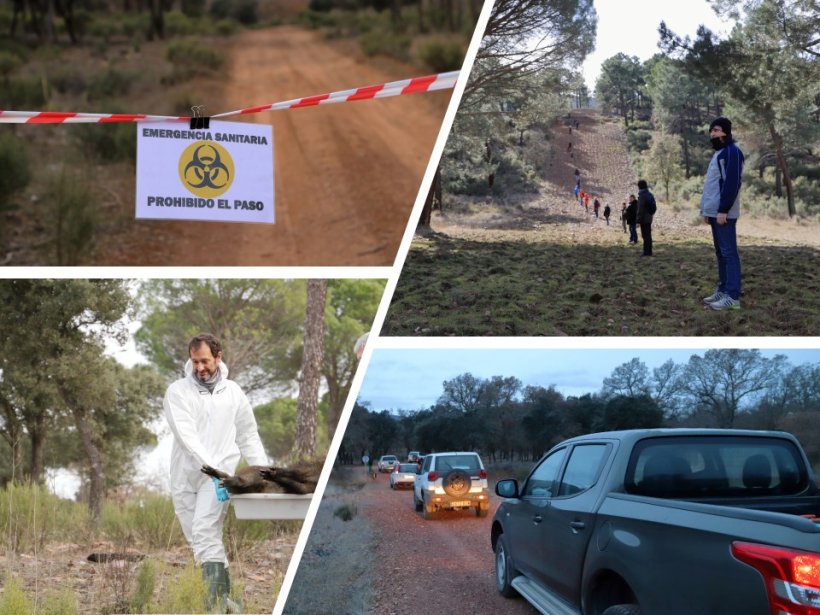Keys to preparation
In a country free of ASF, preparedness involves:
- strengthening farm biosecurity,
- minimizing the risk of introduction into the country,
- optimizing early detection, and
- practicing control measures in case of an outbreak.
The following paragraphs address each of these four points.

Biosecurity on pig farms has generally improved. However, the same level of security cannot be expected in intensive systems as in extensive systems. Often, the costs associated with implementing biosecurity measures and sometimes certain existing regulations (environmental, municipal, etc.) limit farms' ability to comply with all recommendations. For example, regulations requiring the construction of physical barriers, such as perimeter fences, involve significant investments and often require permits that must be obtained from the authorities. Nevertheless, sometimes the simplest measures make a difference. Recent risk analyses have shown, for example, that the use of insect netting significantly reduces the risk of ASF virus entry, highlighting the effectiveness of simple yet fundamental preventative measures. In any case, all farms must join the effort to improve biosecurity. Even a small percentage of non-compliance can cause significant damage to the entire industry.
We know that the most essential biosecurity measure is either a double or a walled boar-proof fence, and there are still many farms that, for one reason or another, do not have one.
It is essential to minimize the risk of introduction through live animals, contaminated products, maritime trade, etc. Today, the importation of infected wild boar into the European Union is, fortunately, highly unlikely. This is due, among other reasons, to the commendable initiative of the Spanish Ministry of Agriculture to prohibit such movements at the EU level. In contrast, trade in live pigs continues to grow.

Figure 1. Number of live pigs imported into Spain (2020-2025).
The trade of live animals in Europe has grown significantly in recent years. Despite the efforts of veterinary authorities and producers, long-distance transport of animals can contribute to the spread of pathogens between different countries and regions, especially if biosecurity protocols are not rigorously followed. The risk is even greater during outbreaks of transboundary diseases, as even small failures in the control chain can have devastating consequences for animal health and the industry's economy.
Regarding animal products, the greatest risks arise when peri-urban wild boars access garbage, as happens in several large cities, at service stations, rest areas, and similar locations frequented by truckers and tourists, especially if these areas are also frequented by wild boars. Wild boars are also present near major ports where thousands of ships from China and other infected countries dock each year. And, of course, there is a risk in pig farms that still allow their workers to bring in homemade food. Any contaminated meat product could trigger an outbreak.
Early detection: Having adequate diagnostic capabilities is essential. The entire swine industry, and especially veterinarians, understands the importance of having adequate diagnostic capacity, which is fundamental for the early detection of this disease. However, fear of the consequences of reporting a possible infection, such as the shutdown of the farm or the application of drastic measures, leads many farmers not to report suspected cases of ASF. This difficulty could be overcome with greater flexibility in access to diagnostic tests. A similar problem occurs in the wild, which is one of the main risk factors for the spread of the virus among wild boar. Due to fear or aversion to paperwork, dead wild boar are rarely reported. Although the hunting sector is aware of the importance of reporting suspected cases, many hunters remain distrustful of the authorities. This mistrust results in insufficient testing, leaving many mortalities unanalyzed. This hinders early detection of the disease.
It is important to raise awareness among hunters that early detection means solving the problem within one or two years. In contrast, the spread of ASF due to late detection will lead to a prolonged epidemic, with dramatic effects on both the swine and hunting sectors.
It is important that countries do their homework: invest in preparedness and surveillance plans, publish specific manuals, launch campaigns targeting transporters, hunters, and other key stakeholders, and define well-defined protocols for any suspected outbreak. Numerous simulations are needed, both for swine and wild boar, and both in tabletop scenarios and under realistic field conditions. These simulations should involve not only official veterinary services, but also hunting organizations, law enforcement agencies, and environmental managers (Figure 2).
However, the German experience shows that all this, although necessary, may not be enough.
Despite having a well-structured veterinary system and advanced preventative measures, the virus could not be stopped from entering the country in 2020 from Poland via infected wild boar. Since then, the virus has become established in wildlife, forcing the massive deployment of resources and containment measures that, years later, are still ongoing with only partial success.

Figure 2. ASF simulations in wild boars.
The conclusion is that we must not let our guard down. Vigilance and early detection, ongoing training, and fluid communication among all stakeholders (producers, veterinarians, hunters, transporters, public administrators) are essential to anticipate potential outbreaks. The key lies not only in reacting well, but in always staying one step ahead of the virus.





